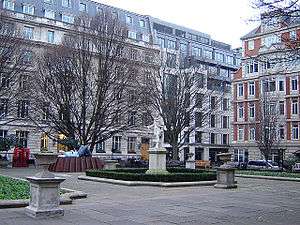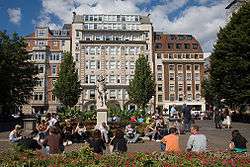Golden Square
Coordinates: 51°30′42″N 0°8′14″W / 51.51167°N 0.13722°W


Golden Square, in the City of Westminster, Soho, London, is one of the historic squares of Central London. The square is just east of Regent Street and north of Piccadilly Circus. The square has featured prominently in literature, and today is a sought-after corporate address for the media-related companies that populate the Soho area.
History
Golden Square is a historic square in the Soho neighbourhood of the City of Westminster.
Possibly laid down by Sir Christopher Wren, the plan bears Wren's signature, but the patent does not state whether it was submitted by the petitioners or whether it originated in Wren's office. This west London square was brought into being from the 1670s onwards. It very rapidly became the political and ambassadorial district of the late 17th and early 18th centuries, housing the Portuguese embassy among others.
The town house of the first Viscount Bolingbroke, much favoured by Queen Anne, was situated on the square. The statue of George II sculpted by John Nost in 1724 came from Cannons House in March 1753.[1] William Pitt the Elder was born in the Square in 1708. There is confusion about whether the statue represents King George II of Great Britain, or King Charles II, as noted on the signage in Golden Square. Folklore states that the statue was accidentally won at auction, when the winning bidder raised his hand to greet a friend. The amount of money he paid was so low that he decided not to contest and gave the statue as a gift to the people of Golden Square.
Literary connections
The square features, albeit in a fictional context, in the third part of Neal Stephenson's Baroque Cycle, The System of the World. An important scene in A Handful of Dust, by Evelyn Waugh, takes place in a nightclub in the fictional Sink Street, off Golden Square. The Square also features in Confessions Of An English Opium Eater by Thomas De Quincey. It is there that he parts for the last time from Anne, the prostitute with whom he falls in love.
Golden Square also features in Charles Dickens' works "David Copperfield" and The Life and Adventures of Nicholas Nickleby. In "Nickleby" it is the square where Ralph Nickleby lives in a spacious house and has his "establishment." Dickens describes the square thus
Although a few members of the graver professions live about Golden Square, it is not exactly in anybody's way to or from anywhere. It is one of the squares that have been; a quarter of the town that has gone down in the world, and taken to letting lodgings. Many of its first and second floors are let, furnished, to single gentlemen; and it takes boarders besides. It is a great resort of foreigners. The dark-complexioned men who wear large rings, and heavy watch-guards, and bushy whiskers, and who congregate under the Opera Colonnade, and about the box-office in the season, between four and five in the afternoon, when they give away the orders,--all live in Golden Square, or within a street of it. Two or three violins and a wind instrument from the Opera band reside within its precincts. Its boarding-houses are musical, and the notes of pianos and harps float in the evening time round the head of the mournful statue, the guardian genius of a little wilderness of shrubs, in the centre of the square. On a summer's night, windows are thrown open, and groups of swarthy moustached men are seen by the passer-by, lounging at the casements, and smoking fearfully. Sounds of gruff voices practising vocal music invade the evening's silence; and the fumes of choice tobacco scent the air. There, snuff and cigars, and German pipes and flutes, and violins and violoncellos, divide the supremacy between them. It is the region of song and smoke. Street bands are on their mettle in Golden Square; and itinerant glee- singers quaver involuntarily as they raise their voices within its boundaries.
Famous Residents
- Actress Frances Alsop moved to Golden Square in 1803.
- Dancer Elizabeth Gamberini resided at No.13 from 1753 to 1763.
- Singer Caterina Gabrielli resided in a house in Golden Square from 1775 to 1776.
- Artist Prince Hoare (younger) resided at No. 16 after 1781.[2]
- Artist Angelica Kauffmann resided at No.16 from 1767 to 1781. In 1768, Kauffmann became one of two female founding members of the Royal Academy in London.
- Portuguese statesman Marquess of Pombal resided at No. 24 from 1739 to 1744.
.jpg) Marquess of Pombal (4624392095)
Marquess of Pombal (4624392095) - Singer Anastasia Robinson resided at No.35 in 1710.
- Artist Martin Archer Shee resided at No.13 from 1796 to 1798. Shee became president of the Royal Academy in 1830.
Current residents
- Phonographic Performance Limited is based at No. 1 Golden Square, also the home of Absolute Radio brand. After its acquisition of Absolute, Bauer Radio began moving all of their London based radio properties, including Planet Rock, to No. 1 to create a London hub.
- Monmouth Dean occupies an office on the first floor of 10 Golden Square.
- Digital Cinema Media (DCM) and the Cinema Advertising Association (CAA) were both located at 12 Golden Square. Most of the cinema advertising in Britain was controlled from this beautiful building. DCM left Golden Square in December 2013 to take up a new building in Regent's Place.
- Both Sony Pictures Entertainment and Sony Computer Entertainment Europe Ltd are located at 25 Golden Square.
- The headquarters of Clear Channel UK,[3] and Clear Channel International[4] are located at No.33 Golden Square.
- No.36 is both the home to the global head office and the London office of M & C Saatchi Group and its subsidiary companies, including M&C Saatchi,[5] M&C Saatchi Mobile,[6] M&C Saatchi Export, LIDA, TALK PR, Play*, Studio 36, and 5th Element.
Golden Square is a regular meeting point for pigeons, who feed from the leftovers of lunchers in the garden.
References
- ↑ Dictionary of British Sculptors, 1660-1851, Rupert Gunnis
- ↑ Survey of London: Vol. 31 and 32, St. James Westminster, Part 2, ed. F.H.W. Sheppard (London, 1963).
- ↑ Clear Channel UK
- ↑ Clear Channel International
- ↑ M&C Saatchi
- ↑ M&C Saatchi Mobile
External links
| Wikimedia Commons has media related to Golden Square (London). |
- Sheppard, FHW, ed. (1963). Survey of London: Volumes 31 and 32, St James Westminster, Part 2. London County Council. pp. 138–145. ISBN 978-0485482317. Retrieved 29 March 2015.